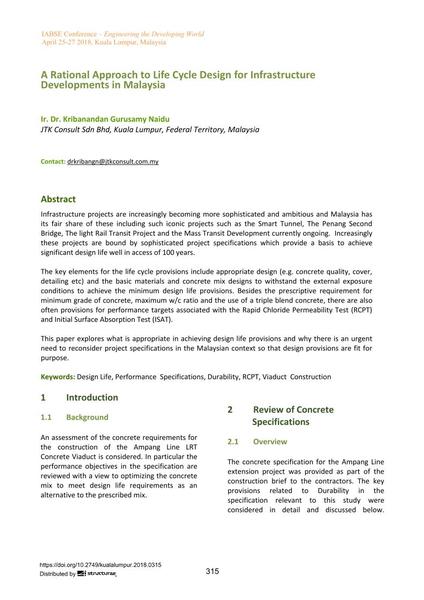A Rational Approach to Life Cycle Design for Infrastructure Developments in Malaysia

|
|
|||||||||||
Bibliographic Details
| Author(s): |
Kribanandan Gurusamy Naidu
(JTK Consult Sdn Bhd, Kuala Lumpur, Federal Territory, Malaysia)
|
||||
|---|---|---|---|---|---|
| Medium: | conference paper | ||||
| Language(s): | English | ||||
| Conference: | IABSE Conference: Engineering the Developing World, Kuala Lumpur, Malaysia, 25-27 April 2018 | ||||
| Published in: | IABSE Conference Kuala Lumpur 2018 | ||||
|
|||||
| Page(s): | 315-322 | ||||
| Total no. of pages: | 8 | ||||
| DOI: | 10.2749/kualalumpur.2018.0315 | ||||
| Abstract: |
Infrastructure projects are increasingly becoming more sophisticated and ambitious and Malaysia has its fair share of these including such iconic projects such as the Smart Tunnel, The Penang Second Bridge, The light Rail Transit Project and the Mass Transit Development currently ongoing. Increasingly these projects are bound by sophisticated project specifications which provide a basis to achieve significant design life well in access of 100 years. The key elements for the life cycle provisions include appropriate design (e.g. concrete quality, cover, detailing etc) and the basic materials and concrete mix designs to withstand the external exposure conditions to achieve the minimum design life provisions. Besides the prescriptive requirement for minimum grade of concrete, maximum w/c ratio and the use of a triple blend concrete, there are also often provisions for performance targets associated with the Rapid Chloride Permeability Test (RCPT) and Initial Surface Absorption Test (ISAT). This paper explores what is appropriate in achieving design life provisions and why there is an urgent need to reconsider project specifications in the Malaysian context so that design provisions are fit for purpose. |
||||
| Keywords: |
durability design life Performance Specifications RCPT Viaduct Construction
|
||||
